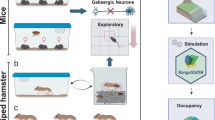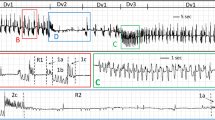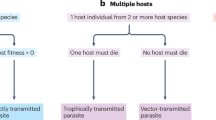Abstract
Empirical evidence from electrophoretic examinations of Metastriate ticks does not support the prediction that these ectoparasites necessarily have low levels of genetic variability within populations and large interpopulation differences. In part, the failure of the theory to produce a parsimonious prediction seems to stem from the use of an inappropriate model based on spatial environmental heterogeneity. The experimental data are better explained in terms of host mobility, tick population size, and the degree of host specificity of the tick.
Similar content being viewed by others
Article PDF
References
Ayala, F J, Tracey, M L, Hedgecock, D, and Richmond, R C. 1975. Genetic differentiation during the speciation process in Drosophila. Evolution 28, 576–592.
Bull, C M, Andrews, R H, and Adams, M. 1984. Patterns of genetic variation in a group of parasites, the Australian reptile ticks. Heredity, 53, 509–525.
Crow, J F, and Kimura, M. 1970. An Introduction to Population Genetics Theory. Harper & Row, Publishers, New York. 591 pp.
Diehl, P A, Aeschlimann, A, and Obenchain, F D. 1982. Tick reproduction: oogenesis and oviposition. The Physiology of Ticks. F. D. Obenchain and R. Galun (eds.), Pergamon Press, New York. 277–350.
Emlen, J M. 1973. Ecology: An evolutionary approach. Addison-Wesley Publishing Company, Reading, Massachusetts. 493 pp.
Healy, J A. 1979a. Phosphoglucomutase polymorphism in the tick Ixodes ricinus. Parasitology, 78, 7–18.
Healy, J A. 1979b. Analysis of α-glycerophosphate dehydrogenase variability in the tick Ixodes ricinus (Acari: Ixodidae). Genetica, 50, 19–30.
Hilburn, L R, and Sattler, P W. Genetic variability in natural populations of Amblyomma americanum (Acari: Ixodidae). Heredity. (In press).
Hochachka, P W, and Somero, G N. 1973. Strategies of Biochemical Adaptation. W. B. Saunders Company, Philadelphia. 358 pp.
Hoogstraal, H, and Aeschlimann, A. 1982. Tick-host specificity. Bull Soc Entomol Suisse, 55, 5–32.
Levins, R. 1962. Theory of fitness in a heterogeneous environment. I. The fitness set and adaptive function. Amer Natur, 96, 361–373.
Levins, R. 1963. Theory of fitness in a heterogeneous environment. II. Developmental flexibility and niche selection. Amer Natur, 97, 75–90.
Levins, R. 1968. Evolution in Changing Environments. Princeton University Press, Princeton, NJ. 120 pp.
Macarthur, R, and Levins, R. 1964. Competition, habitat selection, and character displacement in a patchy environment. Proc NAS, 51, 1207–1210.
Nei, M. 1972. Genetic distance between populations. Am Nat, 106, 283–292.
Nevo, E. 1978. Genetic variation in natural populations: patterns and theory. Theor Pop Biol. 13, 121–177.
Oliver, J H, JR. 1977. Cytogenetics of mites and ticks. Ann Rev Entomol. 22, 407–429.
Oliver, J H, JR. 1982. Tick reproduction: sperm development and cytogenetics. In The Physiology of Ticks. F. D. Obenchain and R. Galun (eds.), Pergamon Press, New York. 245–275.
Oliver, J H, JR, and Stone, B F. 1983. Spermatid production in unfed, Metastriata ticks. J Parasitol. 69, 420–421.
Price, P W. 1977. General concepts on the evolutionary biology of parasites. Evolution, 31, 405–420.
Sattler, P W, Hilburn, L R, and Davey, R B. Linkage relationships among twelve isozyme loci in cattle fever ticks on the genus Boophilus. J Heredity. (In press).
Sattler, P W, Hilburn, L R, Davey, R B, George, J E, and Rojas Avalos, J B. Genetic similarity and variability between natural populations and laboratory colonies of North American Boophilus (Acari: Ixodidae). (In press).
Simon, C, and Archie, J. 1985. An empirical demonstration of the liability of heterozygosity estimates. Evolution, 39, 463–467.
Wallis, G P, and Miller, B R. 1983. Electrophoretic analysis of the ticks Ornithodoros (Pavlovskyella) erraticus and O. (P.) sonrai (Acari: Argasidae). J Med Entomol, 20, 570–571.
Author information
Authors and Affiliations
Rights and permissions
About this article
Cite this article
Hilburn, L., Sattler, P. Are tick populations really less variable and should they be?. Heredity 57, 113–117 (1986). https://doi.org/10.1038/hdy.1986.94
Received:
Issue date:
DOI: https://doi.org/10.1038/hdy.1986.94
This article is cited by
-
Allozyme polymorphism of Mdh and α-Gpdh in Ixodes ricinus populations: comparison of borreliae-infected and uninfected ticks
Experimental and Applied Acarology (2006)
-
Mitochondrial DNA sequence variation in Ixodes pacificus (Acari: Ixodidae)
Heredity (1999)
-
Variability in cuticular hydrocarbons and phenotypic discrimination of Ixodes ricinus populations (Acarina: Ixodidae) from Europe
Experimental and Applied Acarology (1996)
-
Cuticular hydrocarbon gas chromatography analysis of Argas vulgaris, A. polonicus, and their hybrids
Experimental and Applied Acarology (1993)



